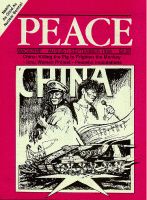
Peace Magazine Aug-Sep 1989, page 24. Some rights reserved.
Search for other articles by Elaine Briere here
ON 7 DECEMBER 1975, nine days after the tiny nation of East Timor declared independence from the disintegrating Portuguese empire, Indonesia invaded. Within three months, according to Indonesia, 60,000 civilians had been killed.
In June 1976, with only 20 percent of the country under its control, Indonesia convened a "People's Assembly" and declared East Timor its 27th province. Amnesty International and the Catholic Church in East Timor estimate that over 200,000 Timorese (out of a population of just under 700,000) have died at Indonesian hands since this time.
The United Nations and the majority of the world's countries have not recognised the Indonesian occupation. Every year scores of human rights and church groups and parliamentarians go to the U.N. Decolonization Hearings in New York to call for Timorese self-determination.
Last September the European Community of countries voted 164 to 12 for a withdrawal of Indonesian troops and a free and fair act of self-determination for East Timor. Western countries have been slow in criticising Indonesia because of business ties and lucrative contracts. The largest foreign investors in Indonesia are Japan, the U.S., Canada, France, the U.K., the Netherlands and West Germany. Japan, the largest supplier of foreign capital to Indonesia, was owed one thirdof its entire foreign debt in 1987 by Indonesia. Canada, Indonesia's third largest foreign investor, supports its efforts to have the issue of East Timor removed from all U.N. agendas, including the Human Rights Commission. Countries that support the Indonesian occupation do so in spite of the fact that the occupation is in violation of basic tenets of the U.N.: territorial integrity and self-determination.
SOME COUNTRIES, such as the U.S., Israel and West Germany, rely on weapons sales as a major foreign exchange earner. Most of these sales go to military regimes in the Third World, who use them against indigenous people and citizens in their own countries. The majority of the world's wars, 72 percent, are now conducted by Third World military regimes against indigenous peoples. The war in East Timor is such a war - so appalling in its human rights abuses that Western countries are not eager for their citizens to learn of their complicity in this attack against a nation of tribal people.
Almost all weapons used in the initial invasion of East Timor were supplied by the U.S. When Indonesia's supplies ran out in 1976 the U.S. gave a massive infusion of military aid, including 16 counter-insurgency aircraft which leveled hundreds of Timorese hamlets and destroyed the agriculture.
This heavy reliance on U.S. weapons changed in the 1980s to a dependence on other major weapons-producing countries, notably the U.K., France, West Germany, Sweden, the Netherlands, South Korea, Canada and Yugoslavia.
Indonesia bought Puma and Super-Puma helicopters from France, AMX tanks, infantry combat vehicles (MJCV) and Exocet missiles and launchers to arm frigates. Two submarines have come from West Germany, and three frigates and a squadron of helicopters from the Netherlands. Sweden has supplied 150 guided missiles and Canada supplies Pratt & Whitney engines for Bell helicopters.
In April 1987, when the war was at its bloodiest, the U.K. sold Indonesia eight Hawk ground attack aircraft. Since then the U.K. has sold 12 more Hawks, three refurbished naval frigates, Seacat launchers and more than 700 British Aerospace Rapier missiles. The lucrative profit margin of the weapons industry is not lost on Indonesia's technocrats. Indonesia is now developing its own military-industrial complex, the centerpiece of which is the Indonesian aerospace company WIN. The president of WIN expects high-tech industry, with arms manufacturing at its core, to be Indonesia's major foreign exchange earner by the year 2000.
In spite of the combined arsenals of the West being at Indonesia's disposal, the Timorese resistance movement (the Front for an Independent East Timor - FRETILIN) has survived in the mountainous areas where most Timorese live.
Indonesia claims that the FRETILIN is defeated and does not have the support of the people. But the number of Indonesian troops poured annually into the country and the fact that most Timorese live in garrisoned villages under the Army's strict control contradicts this. The Center for Defense Information describes the war in East Timor as the most violent conflict taking place today, given the size of the population. In 1986-1987 Indonesia increased its troop strength to 40,000 for "Operation Eradicate, "one in a series of military campaigns aimed at eliminating the FRETILIN.
Human rights and independent aid groups, such as Amnesty International, Asia Watch and the Catholic Institute for International Relations, have not been allowed into East Timor for 13 years. Even the International Committee of the Red Cross, normally allowed into conflict zones, has been refused entry into East Timor's mountains, where massacres of villagers and the poisoning of water supplies are still reported. Though Indonesia said it would open the country to foreigners in 1989, nothing has changed. President Suharto visited East Timor in November 1988, and 3,000 people were arrested in the pacified areas.
The Timorese are in the forefront of the struggle for a just and more humane world. People of industrialised countries are insulated from the wars that destroy people in other parts of the world. Our wars are sanitized and shipped off to far away places. The Timorese show us how necessary it is to regain control over the war-making activities of our own governments. Only the determination of the Timorese people and the persistence of a broad range of human rights groups have ensured that the story of East Timor is being told today.
Elaine Briere, Box 354, Ladysmith, B.C. 604 245 3068.

Peace Magazine Aug-Sep 1989, page 24. Some rights reserved.
Search for other articles by Elaine Briere here